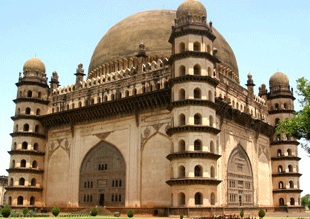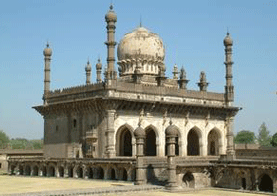|
|
|
Bijapur
|
|
Information about Bijapur |
|
Bijapur was known as Vijayapura "the city of victory" during the reign of Chalukyas. The ancient city of Bijapur is located 530 kms north-west of Bangalore. Bijapur was the capital of the Adil Shahi kings (1489-1686), and one of the five splinter states formed when the Bahmani Muslim kingdom broke up in 1482. Bijapur was also one of the golden cities of the Muslim kings. About 500 years ago, Bijapur was described by foreign historians as a flourishing city with a vast army. This city was located on one of the ancient trade routes, and was visited by scholars and historians of both the East and the West. Bijapur is still strongly Muslim in character and has various places of historical, cultural and architectural importance with the Islamic architecture. There are over 50 temples, more than 20 tombs and an equal number of palaces in Bijapur. The main attractions in Bijapur are the architectural, especially Islamic architecture like the Gol Gumbaz. This magnificent tomb of Mohammed Adil Shah, has a breathtaking whispering gallery and mind boggling accoustic effects.
|
|
|
|
Tourist Attractions in Bijapur |
|
Gol Gumbaz |
|
The word Gol Gumbaz literally means round dome, is the most famous attraction in Bijapur. The Gol Gumbaz is the tomb of Mohammed Adil Shah (1627-56), the seventh ruler of Adilshahi dynasty. This tomb was built at his orders before his death and took about 20 years to complete. This tomb also dominates the landscape of Bijapur. It has a floor area of 1700 square meter, height of 51 m and diameter of 37 m. The walls are 3 m thick. The central dome is second largest dome in the world and second only in size to the dome of St Peter's Basalica in Rome and stands unsupported by any pillars. The tick of a watch or the rustle
of paper or |
 |
|
the pin drop can be heard across a distance of 37 m. in the Whispering Gallery. The main feature of this dome is that a sound is echoed for eleven times. Under the dome are the tombs of the Sultan, his two wives, his mistress Ramba, his daughter and grandson. The octagonal turrets which project at an angle and the huge bracketed cornic below the parapet are important features of this monument. The gallery around the dome can be reached by climbing up the turret passages, and from here one can have a fabulous view of the town. The building complex includes a mosque, Naqqar Khana, gateway and dharmashala. The edifice in front of the tomb has been converted into a museum. |
|
|
Ibrahim Rauza |
 |
The
word Rauza literally means a garden. The Ibrahim
Rauza is a square garden that consists of 2
buildings, one houses the tomb of Ibrahim Adil
Shah II and his family and the other is a
mosque. The tomb was built on the orders of
Ibrahim Adil Shah (1580-1627) and known for its
striking symmetry of proportion, exquisite
minarets, cupolas, parapets and cornices, richly
decorated walls and perforated stone windows. This tomb is supposed to
have been an inspiration for the Taj Mahal at Agra. The
panels are decorated with crosses, lotuses and wheels
and signify the tolerance of the Adil Shahi dynasty.
This monument shows the creativity of its Iranian born
architect. |
|
The tomb is built on a single slab of
bed-rock and the architect has attained a perfect
balance on the site, with the mausoleum on the left and
the prayer hall to the right. This whole structure lies
above a basement which houses secret passages (used to
store munitions and food) and also holds living quarters
for the cavalry, with stables opposite. The gardens are
beautifully sculpted and enclosed within an imposing
wall and have some superb gateways. The architect's
grave also lies within the courtyard. He was buried
there at his request, to be close to the Sultan. Two
stone chains, each carved from a single rock hang from
the sides of the prayer hall. Each door which is made in
teak wood and re-enforced in metal in this complex is
unique. The door handles are made of iron and brass and
provide for some intricate patterns, which are largely
intact. The arches in the hallway that surround the
inner perimeter of the mausoleum are superbly crafted.
The facades of the building provide for some stunning
art-work in stone, including a map to the basement,
which lies under the mausoleum. Another feature of this
tomb is that if you are standing at the mausoleum by the
grave side of the Sultan, you can distinctly hear the
prayers being said at the other end, in the prayer hall.
|
|
|
|
Malik-e-Maidan |
|
Malik-e-Maidan is one of the largest bell metal guns in the world. This gun measures 4.45 m in length, 1.5 m in diameter and weighs 55 tons and placed on the walls of the city. One of the main feature of this cannon is that it is always cool to touch even during the hot summers and when it is tapped gently, it tinkles softly like a bell. According to the legends, if you touch the gun and make a wish, it will come true. The muzzle of the gun is shaped like the head of a lion with open jaws and between the carved fangs is depicted an elephant being crushed to death. |
|
|
Bara Kamaan |
|
Bara Kamaan is the unfinished mausoleum of Ali Adil Shah. If this mausoleum has been completed, it might have surpassed all others of its kind. Its 12 graceful arches which give it the name Bara Kamaan, makes one feel the power of time and death. |
|
|
|
Fort |
|
The huge fort surrounded by
fortified walls and a wide moat was built by Yusuf
Adil Shah I. The relics of palaces and pleasure
gardens with in the fort reflect in 1561, which was
used as a royal residence as well as Durbar Hall. The
Sat Manzil, the seven storeyed palaces of Mohammed
Adil Shah and the Jala Manzil, noted for its
architectural beauty. Another attractions is the Malik
– I – Maidan, a 55 tonne, 4.5 mtrs. Long cannon of
Adil Shahi’s, which is perhaps one of the largest bell
metal guns in the world. Bara Kaman, located nearby is the
incomplete mausoleum of Ali – II, noted for its
graceful arches.
Asar Mahal (5 kms.)
It was built in 1646 by Muhammad Adil Shah to serve as ‘Hall
of Justice’ and has some holy relics of Prophet Mohammed. Other worth seeing monuments are the Mehtar Mahal, the Jod
Gumbaz, Afzal Khans’s Cenotaph,Anand Mahal, Ark– Killa, etc. |
|
|
|
|
Jumma Masjid |
|
Jumma Masjid was known so because the Khutba was recited here on Jumma ie. Friday. This mosque is the largest and first constructed mosque in Bijapur. It was built between 1557-1686, during the rule of Ali Adil Shah, who acquired the land after defeating the rich Ramaraja of Vijayanagar. The total area of the mosque is 10,810 square meter. The main part of the mosque stands to the west and has nine huge arches on the facade that deepen into five arches and form 45 compartments. The majestic tomb rises above the roof in a semicircle and looks like the bud of a flower. The Jama Masjid is mainly known for its harmonious proportions and graceful minarets, ornamental details. The Aurangzeb extended the mosque in the east, south and the north verandah and built the eastern gate. The original gateway is on the northern side. The interior of the mosque shows some decorative motifs on the apexes of the arches. The heavy curtain hangs over the "Mehrab", which has domes, minarets, niches with books, flower vases and Persian writings inscribed on it. The sacred alcove have the Quran daintily painted in the letter of gold. |
|
|
Mehtar Mahal |
|
Mehtar Mahal is the finely wrought gateway to the mosque. It is an excellent example of the
Indo-Saracenic style of architecture. It is embellished by a profusion of carvings in the form of brackets supporting the balconies and stone trellis work in Hindu Style. |
|
|
| |
|
Around Bijapur |
|
Basavana Bagewadi (43 kms.)
The sacred town is the birth place of Saint Basaveshwara,
the 12th century social and religious reformer and prime minister of
the Kalyana Chalukya rulers. It is known for the temple of Basaveshwara with
shrines dedicated to Basaveshwara (Nandi), Sangameshwara, Mallikarjuna and
Ganapathi. There are also fine marble statues of Basavanna and his wife.
Kumatagi (19 kms.)
Kumatagi, the pleasure resort of the Adil Shahi rulers and
nobles lies on the banks of a large reservoir. The water pavilions with a
network of cisterns, fountains and waterspouts are noteworthy. The walls of the
pavilions are adorned with fine frescoes.
Thoravi (6 kms.)
It was chosen as the site of the new
city built by Ibrahim Adil Shah. The main attractions
are the relies of Sangit Mahal, the palace where the emperor is said to have
had dance and music soirees. It is the venue for the annual Nauraspur Music
Festival. There is also a of Narsimha with pre-Vijayanagar
idols. |
|
|
|